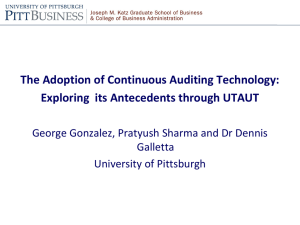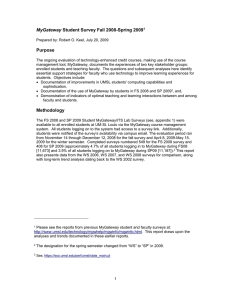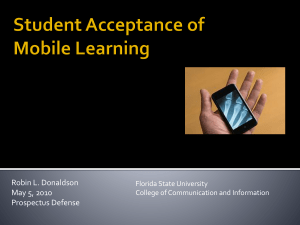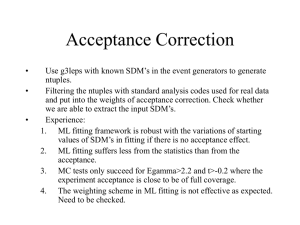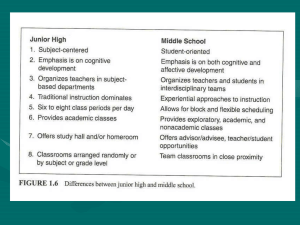Empirical Validation of Unified Theory of Acceptance and Use of
advertisement
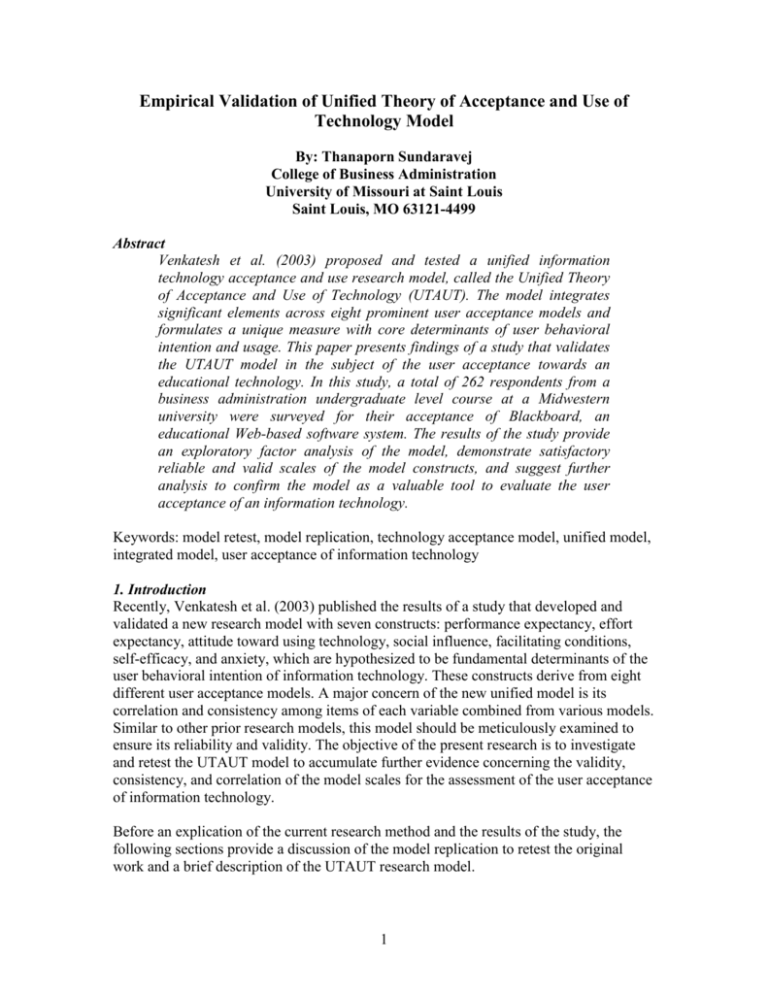
Empirical Validation of Unified Theory of Acceptance and Use of Technology Model By: Thanaporn Sundaravej College of Business Administration University of Missouri at Saint Louis Saint Louis, MO 63121-4499 Abstract Venkatesh et al. (2003) proposed and tested a unified information technology acceptance and use research model, called the Unified Theory of Acceptance and Use of Technology (UTAUT). The model integrates significant elements across eight prominent user acceptance models and formulates a unique measure with core determinants of user behavioral intention and usage. This paper presents findings of a study that validates the UTAUT model in the subject of the user acceptance towards an educational technology. In this study, a total of 262 respondents from a business administration undergraduate level course at a Midwestern university were surveyed for their acceptance of Blackboard, an educational Web-based software system. The results of the study provide an exploratory factor analysis of the model, demonstrate satisfactory reliable and valid scales of the model constructs, and suggest further analysis to confirm the model as a valuable tool to evaluate the user acceptance of an information technology. Keywords: model retest, model replication, technology acceptance model, unified model, integrated model, user acceptance of information technology 1. Introduction Recently, Venkatesh et al. (2003) published the results of a study that developed and validated a new research model with seven constructs: performance expectancy, effort expectancy, attitude toward using technology, social influence, facilitating conditions, self-efficacy, and anxiety, which are hypothesized to be fundamental determinants of the user behavioral intention of information technology. These constructs derive from eight different user acceptance models. A major concern of the new unified model is its correlation and consistency among items of each variable combined from various models. Similar to other prior research models, this model should be meticulously examined to ensure its reliability and validity. The objective of the present research is to investigate and retest the UTAUT model to accumulate further evidence concerning the validity, consistency, and correlation of the model scales for the assessment of the user acceptance of information technology. Before an explication of the current research method and the results of the study, the following sections provide a discussion of the model replication to retest the original work and a brief description of the UTAUT research model. 1 1.1 Model Replication The advancement of knowledge requires the critical examination of prior studies. A model replication or re-examination has been generally conducted in a variety of research fields to assess the consistency, reliability, and validity of the measurement scales of the previous work. Research can be strengthened by a validated instrument. The model validation is a primary process in empirical research. However, the model validation in the management information systems (MIS) research has been inadequate (Straub, 1989). Straub (1989) raises a number of reasons why a model validation, especially in the MIS area, lacks attention from researchers. First, due to rapid changes in technology, researchers feel a need to conduct research with dispatch. Second, theoretical or nonempirical research method that is dominant in MIS research may not require the same validation. Even though, researchers adopt instruments used in prior studies, researchers must be aware that a methodological approach may be altered in a new study. The adapted instrument still needs a retest. With the research confirmation, the inaccuracy in measurement is minimal, resulting in higher confidence in the research findings. As a result, an instrument validation is vital for the replication of published research. The consequence from the model replication lies in two directions: explore new findings (Elgers, 1980; Potiowsky et al., 1985; Anderson et al., 1987; Hogarth et al., 1988; Segars, 1993; Kacmar et al., 1999) or confirm the preceding study (Brown 1990; Adams et al., 1992; Hendrickson et al., 1993; Szajna, 1996; Compeau et al., 1999; Agarwal and Karahanna, 2000). After all, in order to develop a standardized instrument for a research, Doll et al. (1994) summarized the research cycle into two steps: (1) exploring the previous study by developing a hypothesized measurement model from the analysis of empirical data from prior research, and (2) confirming the study by testing the hypothesized measurement model against new gathered data. The current study follows these two steps. This paper will first analyze the UTAUT model, apply the constructs of the model to a different setting, and interpret the results of the study to confirm or reject the UTAUT model as an instrument for future research in the measurement of technology acceptance and usage. 1.2 UTAUT Model For many years, a lot of studies on the MIS implementation have been performed to identify and assess organizational characteristics that lead to an information system success or failure (Ginzberg, 1981). At present, many user acceptance models with different determinants are created to measure the user agreement of information systems which is an important factor to indicate a system success or failure (Melone, 1990). Each theory or model has been widely tested to predict user acceptance (Venkatesh and Davis, 2000; Thompson et al., 1991). However, no comprehensive instrument to measure the variety of perceptions of information technology innovations had existed until Venkatesh et al. (2003) attempted to review and compare the existing user acceptance models with an ultimate goal to develop a unified theory of technology acceptance by integrating every major parallel aspect of user acceptance determinants from those models. 2 The eight original models and theories of individual acceptance that are synthesized by Venkatesh et al. (2003) include the Theory of Reasoned Action (TRA), Technology Acceptance Model (TAM), Motivational Model (MM), Theory of Planned Behavior (TPB), Model Combining the Technology Acceptance Model and Theory of Planned Behavior (C-TAM-TPB), Model of PC Utilization (MPCU), Innovation Diffusion Theory (IDT), and Social Cognitive Theory (SCT). Constructs of each models and theories, including the UTAUT model, are represented in table 1. Models and Theories Theory of Reasoned Action (TRA) by Fishbein and Ajzen (1975) derives from psychology to measure behavioral intention and performance. Technology Acceptance Model (TAM) by Davis (1989) develops new scale with two specific variables to determine user acceptance of technology. Constructs Attitude Subjective norm Perceived Usefulness Perceived Ease of Use Subjective Norm* Experience* Voluntariness* Image* Job Relevance* Output Quality* Result Demonstrability* Technology Acceptance Model 2 (TAM2) by Venkatesh and Davis (2000) is adapted from TAM and includes more variables. * indicates TAM2 only Motivational Model (MM) also stems from psychology to explain behavior. Davis et al. (1992) applies this model to the technology adoption and use. Theory of Planned Behavior (TPB) by Ajzen (1991) extends TRA by including one more variable to determine intention and behavior. Combined TAM and TPB (C-TAM-TPB) by Taylor and Todd (1995). Extrinsic Motivation Intrinsic Motivation Attitude Subjective norm Perceived Behavioral Control Perceived Usefulness Perceived Ease of Use Attitude Subjective norm Perceived Behavioral Control Social Factors Affect Perceived Consequences (Complexity, JobFit, Long-Term Consequences of Use) Facilitating Conditions Habits Relative Advantage* Compatibility* Complexity* Model of PC Utilization (MPCU) by Thompson et al. (1991) is adjusted from the theory of attitudes and behavior by Triandis (1980) to predict PC usage behavior. Innovation Diffusion Theory (IDT) by Rogers (1962) is adapted to information systems innovations by Moore and 3 Benbasat (1991). Five attributes from Rogers’ model and two additional constructs are identified. Observability* Trialability* Image Voluntariness of Use * indicates Roger’s constructs. Social Cognitive Theory (SCT) by Bandura (1986) is applied to information systems by Compeau and Higgins (1995) to determine the usage. Encouragement by Others Others’ Use Support Self-Efficacy Performance Outcome Expectations Personal Outcome Expectations Affect Anxiety Unified Theory of Acceptance and Use of Performance Expectancy Technology Model (UTAUT) by Effort Expectancy Venkatesh et al. (2003) integrates above Attitude toward Using Technology theories and models to measure user Social Influence intention and usage on technology Facilitating Conditions Self-Efficacy Anxiety Table 1: Models and Theories of Individual Acceptance Longitudinal field studies were conducted across heterogeneous contexts. The reliability and validity of each construct from every model were measured. For the new research model, seven constructs appeared to be significant and directly determined the intention of information technology usage. These seven constructs are - performance expectancy: the degree to which an individual believes that using a particular system would improve his or her job performance; - effort expectancy: the degree of simplicity associated with the use of a particular system; - attitude toward using technology: the degree to which an individual believes he or she should use a particular system; - social influence: the degree to which an individual perceives that others believe he or she should use a particular system; - facilitating conditions: the degree to which an individual believes that an organizational and technical infrastructure exists to support the use of a particular system; - self-efficacy: the degree to which an individual judges his or her ability to use a particular system to accomplish a particular job or task; and - anxiety: the degree of anxious or emotional reactions associated with the use of a particular system. 2. Research Method The quantitative phase of the current research focuses on empirically retesting the UTAUT model in a different setting from newly gathered data. The discussion of survey participants, research settings, instrument administration, and research results is provided in this section. 4 2.1 Participants and Settings A pretest was conducted to validate the instrument. Feedback about the layout of the questionnaire and question ambiguity was obtained. Some changes were made to the questionnaires as deemed appropriate. The revised questionnaires were distributed to 394 undergraduate students in a business administration course at a large public university in the Midwest area. There were 294 returned responses, for an overall response rate of 74.62 percent. From the number of these participants, there were 32 invalid returned responses that had to be eliminated before the data analysis. The demographic data of respondents were also collected. Table 2 demonstrates sample characteristics. Sample Characteristics Results Academic Year Freshman 30.38 % Sophomore 15.00 % Junior 40.77 % Senior 13.08 % Other 0.77 % Gender Male 50.38 % Female 49.62 % Age Mean 22.12 S.D. 5.19 Application Experience None 50.77 % 1-2 Semester 30.77 % More than 2 Semester 18.46 % Application Training None 82.31 % 1-5 Hours 16.92 % More than 5 Hours 0.77 % Voluntariness Yes 50.00 % No 50.00 % Table 2: Sample Characteristics The subject of the questionnaire is the assessment of the students’ intention to use Blackboard (named MyGateway at the survey institution) which is a Web-based software system used to support flexible teaching and learning in face-to-face and distance courses. Blackboard is an educational innovation that provides tools and facilities for the online course management, content management and sharing, assessment management, and online collaboration and communication between faculty and students or among students themselves. 2.2 Instrument Administration The 31 questionnaire items were adapted from the UTAUT study of Venkatesh et al. (2003). These items represent independent and dependent variables utilized in the current study. Appendix A demonstrates the questionnaire items to measure the behavioral intention of students to use Blackboard. Other than wording modifications to fit the specific technology studied in this research, no changes were made to the user acceptance scale. All items were measured on a seven point Likert scale, where 1 = completely 5 disagree, 2 = moderately disagree, 3 = somewhat disagree, 4 = neutral (neither disagree nor agree), 5 = somewhat agree, 6 = moderately agree, and 7 = completely agree. 2.3 Results Results of the research can be discussed in three different areas: construct validity, reliability, and correlation. Straub et al. (2004) suggested multiple validation guidelines for the information system research. For the current study, coefficient factor analysis was used to determine the convergent and discriminant construct validity. Cronbach’s Alpha was employed to assess the internal consistency reliability. The inter-item correlation was also utilized to explain the construct reliability. Finally, the regression analysis method explored the relationship between variables. 2.3.1 Assessment of Validity Construct validity is an issue of operationalization or measurement between constructs. The concern on the construct validity is that instrument items selected for a given construct are a reasonable operationalization of the construct (Cronbach and Meehl, 1955). For the present research, the 31 instrument items were selected from eight different user acceptance models. These items are classified into eight constructs in the UTAUT model. For the current study, the renamed abbreviation and descriptive statistics of each construct and item are presented as follows: Scales / Items Performance Expectancy (PE) PE1: I find MyGateway useful in my study. PE2: Using MyGateway enables me to accomplish tasks more quickly. PE3: Using MyGateway increases my productivity. PE4: Using MyGateway increases my chances of getting a good grade. Effort Expectancy (EE) EE1: My interaction with MyGateway is clear and understandable. EE2: It is easy for me to become skillful at using MyGateway. EE3: I find MyGateway easy to use. EE4: Learning to operate MyGateway is easy for me. Attitude toward Using Technology (AT) AT1: Using MyGateway is a good idea. AT2: MyGateway makes study more interesting. AT3: Studying with MyGateway is fun. AT4: I like studying with MyGateway. Social Influence (SI) SI1: People who influence my behavior think that I should use MyGateway. SI2: People who are important to me think that I should use MyGateway. SI3: Professors in my classes have been helpful in the use of MyGateway. SI4: In general, the university has supported the use of MyGateway. Facilitating Conditions (FC) FC1: I have the resources necessary to use MyGateway. FC2: I have the knowledge necessary to use MyGateway. 6 Mean 22.63 6.02 5.72 5.58 5.31 24.21 5.97 6.00 6.11 6.14 19.80 6.10 4.64 4.37 4.69 20.44 4.42 S.D. 4.57 1.17 1.30 1.27 1.45 4.03 1.17 1.12 1.10 1.09 4.87 1.17 1.54 1.54 1.53 4.41 1.57 4.55 5.52 5.96 21.36 6.11 5.80 1.55 1.32 1.18 3.82 1.22 1.68 FC3: MyGateway is not compatible with other systems I use.* FC4: A specific person (or group) is available for assistance with MyGateway difficulties. Self-Efficacy (SE) SE1: I can complete a job or task using MyGateway, if there is no one around to tell me what to do as I go. SE2: I can complete a job or task using MyGateway, if I can call someone for help if I get stuck. SE3: I can complete a job or task using MyGateway, if I have a lot of time to complete the job for which the software is provided. SE4: I can complete a job or task using MyGateway, if I have just the built-in help facility for assistance. Anxiety (AX) AX1: I feel apprehensive about using MyGateway. AX2: It scares me to think that I could lose a lot of information using MyGateway by hitting the wrong key. AX3: I hesitate to use MyGateway for fear of making mistakes I cannot correct. AX4: MyGateway is somewhat intimidating to me. Behavioral Intention to Use the System (BI) BI1: I intend to use MyGateway in the next semesters. BI2: I predict I would use MyGateway in the next semesters. BI3: I plan to use MyGateway in the next semesters Note: * indicates reversed scale. Table 3: Descriptive Statistics 4.68 4.78 2.03 1.58 20.07 5.55 4.66 1.35 5.01 1.50 4.91 1.49 4.59 1.67 11.18 3.19 2.97 6.25 2.04 1.97 2.45 1.76 2.57 18.72 6.15 6.28 6.29 1.95 3.45 1.27 1.16 1.15 First of all, the correlation among constructs was examined. The factor loading for scale items based on the VARIMAX rotation is shown in table 4. The highest total variance of the item loading represented 75.55 percent without the construct FC and items AT1, SE1, SI3 and SI4. As such, these eight items were dropped from the experiment. Most of the remaining items represented good convergent and discriminant properties. Only items AT and SI tend to group together. This occurrence could be interpreted to mean that both of these constructs are attitudes on technology usage. AT is the user’s own attitude toward using technology and SI is the attitude of people who influence the user toward using technology. Items representing subcomponents of the same construct were all significantly and highly correlated. Twenty three items were divided into six constructs. Overall, the constructs developed by Venkatesh et al. (2003) fared well in this replication, even though they were based on different samples and context settings. This is vital because it indicates the general applicability of these constructs for different types of research questions. Summarily, this analysis confirms the validity analysis of the UTAUT model by showing strong correlation for most items belonging to the same construct. 7 AT3 SI1 AT4 AT2 SI2 EE4 EE3 EE2 EE1 PE3 PE2 PE1 PE4 AX3 AX2 AX4 AX1 BI2 BI3 BI1 SE3 SE2 SE4 1 .829 .810 .800 .798 .796 .101 .098 .136 .138 .354 .330 .212 .384 .061 .038 .071 .105 .115 .156 .133 .227 .255 .169 2 .136 .001 .086 .110 .097 .873 .865 .852 .822 .192 .173 .318 .190 -.151 -.052 -.163 -.102 .248 .282 .289 .071 .169 .070 Component 3 4 .261 .002 .015 .106 .231 .009 .315 .028 .056 .119 .090 -.169 .153 -.144 .159 -.089 .236 -.094 -.036 .807 -.037 .804 -.050 .735 .038 .692 .001 .885 .045 .841 -.118 .792 .002 .651 .267 -.156 .226 -.155 .189 -.172 .124 .068 .112 .027 .056 .088 5 .004 .096 .077 -.003 .084 .171 .141 .149 .134 .175 .193 .238 .089 -.163 -.049 -.128 -.009 .870 .869 .840 .153 .022 .090 6 .079 .168 .136 .073 .119 .098 .065 .032 .095 .090 .115 .096 .063 -.030 .066 -.092 .288 .090 .113 .137 .832 .803 .787 Note: Item loadings on their theoretically associated factor are highlighted in bold. Table 4: Factor Analysis with VARIMAX Rotation 2.3.2 Assessment of Reliability While the construct validity is a measurement between constructs, the reliability is a measurement within a construct. The concern on reliability is how well a set of instrument items selected for a given construct measures the same construct. For this study, to analyze whether one construct is independent of and calculated separately from that of other constructs, the Cronbach’s Alpha method and Inter-Item Correlation Matrix are used. Every construct in table 5 demonstrates a high level of reliability coefficient or internal consistency. Note that a reliability coefficient of .70 or higher is generally considered acceptable, according to Venkatesh et al. (2003). For the constructs in the present experiment, the numbers of the Cronbach’s Alpha are .90 for AT&SI, .92 for EE, .90 for PE, .82 for AX, .96 for BI, and .82 for SE, confirming the results of reliability analysis of constructs from the UTAUT model. 8 Construct Cronbach’s Alpha AT&SI .90 EE .92 PE .90 AX .82 BI .96 SE .82 Table 5: Internal Factor Reliability by Cronbach’s Alpha Technique Additionally, the correlation among variables presented in table 6 reflects the selfdetermining relationship between variables. All off-diagonal elements are close to zero, representing strong independence of each construct. The results of inter-item correlation matrix provide more evidence to prove the reliability of the UTAUT scales. AT&SI PE 1.000 .272 AT&SI .272 1.000 PE .578 .478 EE .130 -.272 SE .272 .508 AX .413 .247 BI Table 6: Inter-Item Correlation Matrix EE .578 .478 1.000 -.059 .506 .331 SE .130 -.272 -.059 1.000 -.280 .128 AX .272 .508 .506 -.280 1.000 .290 BI .413 .247 .331 .128 .290 1.000 2.3.3 Assessment of Correlation Based on the earlier validity and reliability analysis, AT&SI, EE, PE, AX, and SE were thought to be potentially important determinants of the behavioral intention to use the system. The R-Square value for the model of the current study is approximately .40, which is relatively high to determine the strength of linear relationship between the independent (AT&SI, EE, PE, AX, and SE) and dependent (BI) variables. However, after further analysis in the regression coefficient, the results demonstrate that only PE, EE, AX and SE affect BI, as shown in the below research model. Meanwhile, AT&SI is not significant to BI. 9 Attitude & Social Influence Effort Expectancy Performance Expectancy .26 (0.00)* Behavioral Intention to Use the System .34 (0.00)* -.21 (0.00)* Anxiety .15 (0.01)* Self-Efficacy * supported at the .01 level Figure 1: Research Model The data from table 7 shows that the coefficients for EE, PE, AX, and SE are statistically significant (p-value <= .01). Moreover, PE is found to have the greatest impact on BI (β = .34). The data also demonstrate that EE (β = .26), AX (β = -.21), and SE (β = .15) are important element to the BI assessment. Finally, the data indicate that AT&SI is not significant to the BI assessment. Nor is the coefficient for AT&SI (β = -.264) statistically significant, compared to EE, PE, AX, and SE. In summary, the result from the experiment can be interpreted to mean that only effort expectancy, performance expectancy, anxiety, and self-efficacy are significant factors to determine the students’ acceptance on Blackboard. Predictor Standardized Variables Coefficients (SE) AT&SI -.264 (.227) EE .26 (.376) PE .34 (.323) AX -.21 (.128) SE .15 (.232) R-Square (R-Square Adjusted) Table 7: Regression Coefficients for Predictors Significance .64 .00 .00 .00 .01 .40 (.38) The findings from the correlation analysis of the current study, however, are found to be different from the results of UTAUT empirical validation by Venkatesh et al. (2003). In Venkatesh et al. (2003)’s experiment, data were gathered from two organizations to validate UTAUT and to increase validity of the preliminary test on the model. It appeared that performance expectancy, effort expectancy, and social influence affect the behavioral 10 intention, while facilitating conditions, attitude toward using technology, self-efficacy, and anxiety do not influence the behavioral intention. For the present study, social influence, which is combined with attitude toward using technology, yields an insignificant effect on the behavioral intention, whereas anxiety and self-efficacy appear to be correlated with the behavioral intention to use Blackboard. However, it should be recognized that Venkatesh et al. (2003) conducted the studies across technologies, organizations, industries, business functions, nature of use (voluntary VS. mandatory), and users’ experience. Contrarily, the current research was conducted with a single time frame, which is the post-adoption period, without a consideration on moderators such as experience, gender, age, and voluntariness of research participants that may diminish or intensify the relationship between independent and dependent variables. For instance, in the current study, half of users claim that there is no pressure or force from professors to use Blackboard as a study tool in classes. According to Venkatesh et al. (2003), the influence of society on behavioral intention will be stronger in mandatory setting. This may be a main reason why the social influence (with attitude toward using technology) loses its significance when users have no pressure from others to use the technology, resulting in disappearance of the solid relationship between this construct and the behavioral intention in the current research model. To confirm the novel findings from the current study, another experiment was conducted. The new approach divided the same samples into two halves. The first half was deployed to re-test the coefficient factor analysis and correlation analysis. The result was similar to the former experiment conducted for the current study. The construct FC and items AT1, SE1, SI3 and SI4 still caused the crossed loading among constructs. Items AT and SI remain in the same group. Another half of data was, subsequently, utilized to conduct the regression analysis, based on the result gained from the first half of the data. Again, the outcome from the experiment is consistent with the former result. AT&SI is not significant to BI, while the rest of constructs appear to influence BI. 3. Conclusions Incompetence or instability of a research model across samples may result in an incorrect measurement of research outcomes. To eliminate this problem, measurement models must be meticulously assessed. Analyses in this study were developed from the foundations of various models and theories and ultimately generated an exploratory research approach by providing a statistical basis for measurement assessment and model testing. In conclusion, the research approach taken in this analysis has yielded three main insights concerning the UTAUT model replication. First, the coefficient factor analysis proved the acceptable construct validity of the model, even though some variables and items needed to be omitted or merged in the current experiment. Second, items of each scale obtained a high Cronbach’s Alpha reliability, while each scale contained a low inter-item correlation 11 value. Finally, from the five indicators of the behavioral intention of the information technology usage, four factors appeared well-suited to the correlations for the current study. Particularly, this four-factor model exhibited a significant degree of correlations between variables. 3.1 Limitations The present research has a limitation that should be addressed. The original field studies of Venkatesh et al. (2003) to measure the UTAUT model were longitudinal observational designs across industries, while the experimental replication of the current findings did not employ the same research approach. The collected information of moderators used in the original model such as experience, gender, age, and voluntariness has not been accounted for in the current research model. Future studies to retest the UTAUT model with these moderators are encouraged because these factors may better predict the usage behavior indication. 3.2 Recommendations for Future Research Although, the UTAUT model developed by Venkatesh et al. (2003) appears to have been acceptably robust across studies and user groups, the model should not be considered as the final instrument to determine the information technology usage. The findings reported in this study should serve to remind interested observers that no absolute research model exists across varying technological and organizational settings. To judge whether an item is correlated to a construct or whether a variable of the model is significant depends on each context. Nonetheless, such findings do not diminish the value of Venkatesh et al. (2003)’s original scales or the value of identifying measures that explain technology acceptance. Instead, they challenge information system researchers to further explore the specific influences of factors that may alter the behavioral intention to use an information system in other settings. The present study simply provides evidence that the UTAUT model is an adequately valid and reliable instrument to measure the usage behavior on information technology. Further investigation is still needed. Future research might focus on using confirmatory research approach to revise and improve the instrument. Experience, gender, age, and voluntariness of research participants are recommended for inclusion in the future model. Longitudinal observation in different settings is also encouraged. 12 References Adams, Dennis A., Nelson, Ryan R., Todd, Peter A. “Perceived Usefulness, Ease of Use, and Usage of Information Technology: A Replication,” MIS Quarterly, 16 (1992): 227-247. Agarwal, Ritu, Karahanna, Elena. “Time Flies When You’re Having Fun: Cognitive Absorption and Beliefs about Information Technology Usage,” MIS Quarterly, 24 (2000): 665-694. Ajzen, Icek. “The Theory of Planned Behavior,” Organizational Behavior and Human Decision Processes, 50 (1991): 179-211. Anderson, Erin, Chu, Wujin, Weitz, Barton. “Industrial Purchasing: An Empirical Exploration of the Buyclass Framework,” Journal of Marketing, 51 (1987): 7186. Bandura, Albert. Social Foundations of Thought and Action: A Social Cognitive Theory, NJ: Prentice Hall, 1986. Brown, R. L. “The Robustness of 2SLS Estimation of a Non-Normally Distributed Confirmatory Factor Analysis Model,” Multivariate Behavioral Research, 25 (1990): 455-466. Compeau, Deborah R., Higgins, Christopher A. “Computer Self-Efficacy: Development of a Measure and Initial Test,” MIS Quarterly, 19 (1995): 189-211. Compeau, Deborah R., Higgins, Christopher A., Huff, Sid. “Social Cognitive Theory and Individual Reactions to Computing Technology: A Longitudinal Study,” MIS Quarterly, 23 (1999): 145-158. Cronbach, L. J., Meehl, P. E. “Construct Validity in Psychological Tests,” Psychological Bulletin, 4 (1955): 281-302. Davis, Fred D. “Perceived Usefulness, Perceived Ease of Use, and User Acceptance of Information Technology,” MIS Quarterly, 13 (1989): 319-340. Davis, Fred D., Bagozzi, R. P., Warshaw, P. R., “Extrinsic and Intrinsic Motivation to Use Computers in the Workplace,” Journal of Applied Social Psychology, 22 (1992): 1111-1132. Doll, William J., Xia, Weidong, Torkzadeh, Gholamreza. “A Confirmatory Factor Analysis of the End-User Computing Satisfaction Instrument,” MIS Quarterly, 18 (1994): 453-461. Elgers, Pieter T. “Accounting-Based Risk Predictions: A Re-Examination,” MIS Quarterly, 55 (1980): 389-408. Fishbein, Martin, Ajzen, Icek. Belief, Attitude, Intention and Behavior: An Introduction to Theory and Research, MA: Addision-Wesley, 1975. Ginzberg, Michael J. “Key Recurrent Issues in the MIS Implementation Process,” MIS Quarterly, 5 (1981): 47-59. Hendrickson, Anthony R., Massey, Patti D., Cronan, Timothy P. “On the Test-Retest Reliability of Perceived Usefulness and Perceived Ease of Use Scales,” MIS Quarterly, 17 (1993): 227-230. Hogarth, Robin M., Makridakis, Spyros. “Consider the Principal Finding: A Reply to William T. Ross,” Management Science, 34 (1988): 672-673. Kacmar, Michele K., Bozeman, Dennis P., Carlson, Dawn S., Anthony, William P. “An Examination of the Perceptions of Organizational Politics Model: Replication and Extension,” Human Relations, 52 (1999): 383-416. Melone, Nancy P. “A Theoretical Assessment of the User-Satisfaction Construct in Information Systems Research,” Management Science, 36 (1990): 76-91. Moore, Gary C., Benbasat, Izak. “Development of an Instrument to Measure the Perceptions of Adopting an Information Technology Innovation,” Information Systems Research, 2 (1991): 192-222. Potiowsky, Thomas P., Koot, Ronald S., Smith, James W. “Factor Analysis and the Empirical Definition of Money,” Quarterly Journal of Business and Economics, (1985): 104-119. Rogers, Everett M. Diffusion of Innovations, NY: Free Press, 1962. Segars, Albert H., Grover, Varun. “Re-Examining Perceived Ease of Use and Usefulness: a Confirmatory Factor Analysis,” MIS Quarterly, 17 (1993): 517-525. Straub, Detmar W. “Validating Instruments in MIS Research,” MIS Quarterly, 13 (1989): 147-169. Straub, Detmar W., Boudreau, Marie-Claude. “Validation Guidelines for IS Positivist Research,” Communications of the Association for Information Systems, 13 (2004): 380-427. Szajna, Bernadette. “Empirical Evaluation of the Revised Technology Acceptance Model,” Management Science, 42 (1996): 85-92. Taylor, Shirley, Todd, Peter A. “Assessing IT Usage: The Role of Prior Experience,” MIS Quarterly, 19 (1995): 561-570. Thomson, Ronald L., Higgins, Christopher A., Howell, Jane M. “Personal Computing: Toward a Conceptual Model of Utilization,” MIS Quarterly, 15 (1991): 124-143. Triandis, Harry C. “Values, Attitudes, and Interpersonal Behavior,” Nebraska Symposium on Motivation, 27 (1980): 195-259. Venkatesh, Viswanath, David, Fred D., “A Theoretical Extension of the Technology Acceptance Model: Four Longitudinal Field Studies,” Management Science, 46 (2000): 186-204. Venkatesh, Viswanath, Morris, Michael G., Davis, Gordon B., Davis, Fred D. “User Acceptance of Information Technology: Toward a Unified View,” MIS Quarterly, 27 (2003): 425-478. Appendix A: Questionnaire Survey on MyGateway MyGateway is a Web-based software system which is used to support flexible teaching and learning in face-toface and distance courses. It provides tools and facilities for online course management, content management and sharing, assessment management, and online collaboration and communication. Please circle the appropriate number to indicate the level of your agreement or disagreement with the following statements on a scale of 1 to 7, where 1 = completely disagree, 2 = moderately disagree, 3 = somewhat disagree, 4 = neutral (neither disagree nor agree), 5 = somewhat agree, 6 = moderately agree, and 7 = completely. Completely Disagree I find MyGateway useful in my study. Using MyGateway enables me to accomplish tasks more quickly. Using MyGateway increases my productivity. Using MyGateway increases my chances of getting a good grade. My interaction with MyGateway is clear and understandable. It is easy for me to become skillful at using MyGateway. I find MyGateway easy to use. Learning to operate MyGateway is easy for me. Using MyGateway is a good idea. MyGateway makes study more interesting. Studying with MyGateway is fun. I like studying with MyGateway. People who influence my behavior think that I should use MyGateway. People who are important to me think that I should use MyGateway. Professors in my classes have been helpful in the use of MyGateway. In general, the university has supported the use of MyGateway. I have the resources necessary to use MyGateway. I have the knowledge necessary to use MyGateway. MyGateway is not compatible with other systems I use. A specific person (or group) is available for assistance with MyGateway difficulties. I can complete a job or task using MyGateway, if there is no one around to tell me what to do as I go. I can complete a job or task using MyGateway, if I can call someone for help if I get stuck. I can complete a job or task using MyGateway, if I have a lot of time to complete the job for which the software is provided. I can complete a job or task using MyGateway, if I have just the built-in help facility for assistance. I feel apprehensive about using MyGateway. It scares me to think that I could lose a lot of information using MyGateway by hitting the wrong key. I hesitate to use MyGateway for fear of making mistakes I cannot correct. MyGateway is somewhat intimidating to me. I intend to use MyGateway in the next semesters. I predict I would use MyGateway in the next semesters. I plan to use MyGateway in the next semesters. 1 1 1 1 1 1 1 1 1 1 1 1 1 1 1 1 1 1 1 1 Completely Agree Neutral 2 2 2 2 2 2 2 2 2 2 2 2 2 2 2 2 2 2 2 2 3 3 3 3 3 3 3 3 3 3 3 3 3 3 3 3 3 3 3 3 4 4 4 4 4 4 4 4 4 4 4 4 4 4 4 4 4 4 4 4 5 5 5 5 5 5 5 5 5 5 5 5 5 5 5 5 5 5 5 5 6 6 6 6 6 6 6 6 6 6 6 6 6 6 6 6 6 6 6 6 7 7 7 7 7 7 7 7 7 7 7 7 7 7 7 7 7 7 7 7 1 2 3 4 5 6 7 1 2 3 4 5 6 7 1 2 3 4 5 6 7 1 2 3 4 5 6 7 1 2 3 4 5 6 7 1 1 1 1 1 1 2 2 2 2 2 2 3 3 3 3 3 3 4 4 4 4 4 4 5 5 5 5 5 5 6 6 6 6 6 6 7 7 7 7 7 7 Participant Information The intent of this section is to obtain some information about individuals who respond to this survey. Information gathered about participants will be treated confidentially, and only group data will be reported as an outcome of this research. 1. Your academic year: __Freshman 2. Gender: __Female __Sophomore __Junior __Senior __Others __Male 3. Age: ______ 4. How long have you used MyGateway? __0-1 Semester __1-2 Semester(s) __More than 2 Semesters 5. How much training did you receive in using MyGateway as a study tool? __None __1-5 Hours __More than 5 Hours 6. Is there any kind of pressure or force from professors to use MyGateway as a study tool in your classes? __Yes __No
